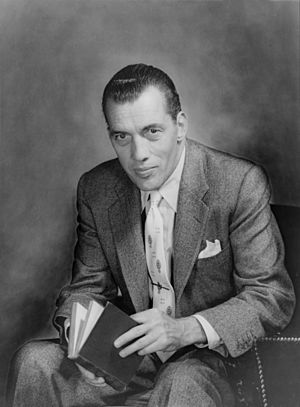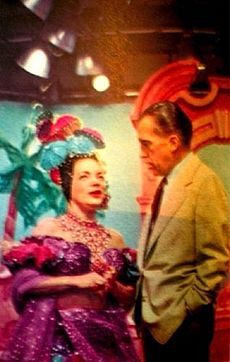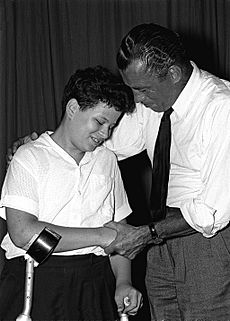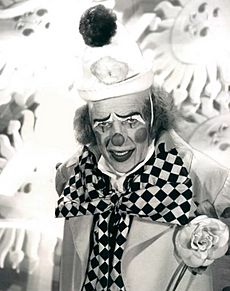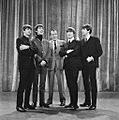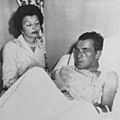Ed Sullivan facts for kids
Edward Vincent Sullivan (born September 28, 1901 – died October 13, 1974) was a famous American television host. He was also a reporter and wrote newspaper columns. Ed Sullivan is best known for creating and hosting The Ed Sullivan Show. This show was on TV from 1948 to 1971. It became the longest-running variety show in U.S. history. Many people remember it as a very important part of American TV history.
Ed Sullivan was a pioneer in early American television. He brought all kinds of acts to TV. Before music channels existed, he showed rock bands. Before channels for jazz or classical music, he featured those too. He also helped new comedians become famous. Before there were hundreds of TV channels, The Ed Sullivan Show was the place to see all sorts of entertainment. In 1996, TV Guide magazine ranked him among the "50 Greatest TV Stars of All Time."
Contents
Early Life and Career
Edward Vincent Sullivan was born on September 28, 1901, in Harlem, New York City. His parents were Elizabeth and Peter Sullivan. He had a twin brother, Daniel, who sadly lived only a few months. Ed grew up in Port Chester, New York. His family loved music and often played the piano and sang.
Ed was a talented athlete in high school. He earned 12 athletic awards at Port Chester High School. He played football, basketball, and ran track. He was also the captain of the baseball team, leading them to win several championships. Ed remembered that in his high school sports, players of all backgrounds were treated equally. This helped him believe that everyone was a worthy opponent.
Ed's first job was at The Port Chester Daily Item, a local newspaper. He had written sports news for them in high school. After graduating, he joined the paper full-time. He then worked for several other newspapers, mostly as a sports reporter. In 1927, he joined The New York Evening Graphic. He started as a sports writer and later became a sports editor.
In 1929, Ed became a Broadway columnist for the New York Evening Graphic. He then moved to the bigger New York Daily News. His column, "Little Old New York," focused on Broadway shows and celebrity news. He also shared entertainment news on the radio. In 1933, Ed wrote and starred in a movie called Mr. Broadway. In the film, he showed audiences around New York's nightlife spots to meet famous people.
Ed Sullivan became a powerful person in the entertainment world. He had a friendly rivalry with another famous columnist, Walter Winchell. Ed continued writing for the New York Daily News even while hosting his TV show. His popularity lasted much longer than Winchell's.
Throughout his career as a columnist, Ed also produced vaudeville shows. He often acted as the host for these shows in the 1920s and 1930s. He also directed a radio program and organized charity events.
Radio
In 1941, Ed Sullivan became the host of Summer Silver Theater. This was a variety show on CBS radio. It featured a different guest star each week.
Television

In 1948, a producer named Marlo Lewis convinced CBS to hire Ed Sullivan. They wanted him to host a weekly Sunday-night TV variety show. It was first called Toast of the Town. Later, it became The Ed Sullivan Show. The first show aired in June 1948. It was broadcast from a theater in New York. In 1953, the show moved to CBS-TV Studio 50. This studio was later renamed the Ed Sullivan Theater in 1967. Today, it's where The Late Show with Stephen Colbert is filmed.
When the show first started, TV critics didn't give Ed very good reviews. He wasn't a natural actor. Even years later, people wondered what his special talent was. His movements on camera were sometimes awkward. Some viewers even thought he had a medical condition.
Ed Sullivan had a good sense of humor about himself. He even let and encouraged people to imitate him on his own show. Famous impersonators like John Byner and Will Jordan would copy his stiff movements and nasal voice. They would often use phrases like "And now, right here on our stage..." or "a really big shew" (meaning "show"). Will Jordan played Ed Sullivan in several movies, including The Buddy Holly Story.
Ed Sullivan also appeared as himself in other films and musicals. He played himself in Jerry Lewis's 1964 film The Patsy. He also appeared in the 1963 film version of the musical Bye Bye Birdie. In 1954, he co-hosted a TV musical special celebrating the work of Rodgers and Hammerstein.
Legacy
Ed Sullivan once said that he never asked performers about their religion, race, or politics. He hired them based on their talent. He believed this helped his show gain a wide and loyal audience.
At first, Ed was unsure about booking Elvis Presley because of his wild image. But Elvis became so popular that Ed couldn't ignore him. In 1956, Elvis appeared on the show three times. After getting to know Elvis, Ed told his audience that Elvis was a "real decent, fine boy."
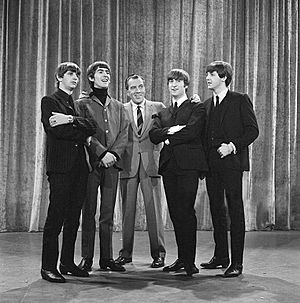
Ed Sullivan wanted to be the first to book the next big music sensation. In November 1963, he saw the huge excitement around the Beatles at an airport. Even though the Beatles didn't have a hit song in the U.S. yet, Ed decided to book them. Their first appearance on February 9, 1964, was the most-watched TV program ever at that time. The Beatles appeared three more times live. Other British groups, like The Dave Clark Five, also appeared many times.
Unlike many shows back then, Ed Sullivan usually asked musical acts to perform live. They didn't just lip-sync to their recordings. However, there were some exceptions. For example, when B.J. Thomas sang "Raindrops Keep Fallin' on My Head" in 1969, water was sprinkled on him for a special effect. In 1969, the Jackson 5 performed their first single, "I Want You Back," on the show.
Ed Sullivan was known for supporting black talent. In the early 1950s, before it was common, he featured many black entertainers. These included legends like Peg Leg Bates and Pigmeat Markham. He also hosted early TV appearances by Bo Diddley, the Platters, and many Motown acts like the Supremes. They appeared 17 times on his show. A critic named John Leonard said that almost every important black artist appeared on Ed's show. Ed Sullivan also stood up to pressure to exclude black entertainers or avoid interacting with them on screen.
Ed Sullivan also featured country and western music. This helped open the door for other country music shows later on. The Canadian comedy duo Wayne and Shuster appeared on the show more than any other act, with 67 appearances.
Ed Sullivan also appeared as himself on other TV shows. In 1961, he filled in for Red Skelton on The Red Skelton Show.
Personality
Ed Sullivan could get upset quickly if he felt someone had wronged him. He could hold a grudge for a long time. He once said, "I flare up, then I go around apologizing." He was known for his "Irish temper." Some of his most famous disagreements were with performers like Bo Diddley and Jim Morrison.
Moe Howard from the Three Stooges remembered that Ed sometimes had trouble remembering names. On their first appearance, Ed introduced them as the "Three Ritz Brothers." He quickly fixed it by saying, "who look more like the Three Stooges to me."
Diana Ross of The Supremes was very fond of Ed Sullivan. She recalled that he often couldn't remember their names. He would just call them "the girls."
Paul McCartney met Ed Sullivan again in the early 1970s. McCartney said that Ed didn't seem to know who he was. McCartney tried to remind him he was one of the Beatles, but Ed just smiled, shook his hand, and left. Some people believe Ed was becoming forgetful later in his life.
Politics
Like many entertainers, Ed Sullivan was involved in the Cold War period of the 1940s and 1950s. This was a time when people were very concerned about communism. In 1950, a tap dancer named Paul Draper was scheduled to appear on Toast of the Town. An activist group tried to stop his appearance, calling him a "Communist sympathizer." Draper denied the charge and appeared on the show. However, Ed Sullivan had to promise his show's sponsor that he would avoid controversial guests in the future.
After this incident, Ed Sullivan worked with a newsletter that focused on anti-communism. He would ask them if there were any concerns about a guest's political views.
Ed Sullivan also had disagreements with CBS's rules about what could be shown on TV. In 1963, Bob Dylan was booked to sing a song called "Talkin' John Birch Paranoid Blues." This song made fun of a very conservative group. During rehearsals, no one had a problem with it. But on the day of the show, CBS's rules department said the song couldn't be performed. They worried that some lyrics might lead to a lawsuit. Dylan was offered to sing a different song, but he refused. He said if he couldn't sing his chosen song, he wouldn't appear at all. Ed Sullivan spoke out against the network's decision in interviews.
In 1956, actress Ingrid Bergman was planning to return to Hollywood after living in Europe. She had faced public criticism for her personal life. Ed Sullivan believed the American public would welcome her back. He invited her to appear on his show and even flew to Europe to film an interview with her. But when he returned, CBS's rules department said she could not appear on the show. Ed's prediction was right, though. Ingrid Bergman later won an Academy Award and regained her fans' support.
Personal Life
Ed Sullivan was engaged to a champion swimmer named Sybil Bauer. Sadly, she died of cancer in 1927 when she was 23.
In 1926, Ed met Sylvia Weinstein. They started dating, but their families were against them marrying because they had different religious backgrounds. This caused their relationship to be on-and-off for three years. They finally married on April 28, 1930. Eight months later, Sylvia gave birth to their daughter, Elizabeth, who they called Betty. In 1952, Betty Sullivan married Bob Precht, who became a producer for The Ed Sullivan Show.
The Sullivans lived in a suite of rooms at the Hotel Delmonico in New York City. Ed used a suite next door as his office until his show was canceled in 1971. He always called his wife after every show to get her opinion.
The Sullivans often went to famous clubs and restaurants in New York City. Ed's friends included many celebrities and even U.S. Presidents. He also met with Popes.
Sylvia Sullivan helped her husband with his finances. She passed away on March 16, 1973.
Later Years and Death
In 1965, CBS began showing its weekly programs in color. The Ed Sullivan Show was seen live in some parts of the U.S. but was taped for other areas. Many parts of the show are now available to watch online.
By 1971, the show's popularity had dropped. CBS decided to cancel the program in March 1971. Ed Sullivan was upset and refused to host the last few months of scheduled shows. Reruns were shown instead, and the final program aired without him in June. He still worked with CBS in other ways. He hosted a 25th-anniversary special for his show in June 1973.
In September 1974, Ed Sullivan was diagnosed with a serious illness. Doctors knew he didn't have much time, but his family chose not to tell him. Ed, who had smoked for many years, thought his illness was related to stomach problems he had. Ed Sullivan died on October 13, 1974, in New York. His funeral was held at St. Patrick's Cathedral, New York, and 2,000 people attended. He is buried at the Ferncliff Cemetery in Hartsdale, New York.
Ed Sullivan has a star on the Hollywood Walk of Fame. In 1985, he was welcomed into the Television Academy Hall of Fame.
Images for kids
-
Sullivan with Cole Porter on Toast of the Town, 1952
-
Carmen Miranda on The Ed Sullivan Show, 1953
-
Sullivan congratulates 13-year-old Itzhak Perlman after a concert in Tel Aviv, 1958.
-
Sullivan with The Beatles, 1964
-
Sullivan's star on the Hollywood Walk of Fame
See also
 In Spanish: Ed Sullivan para niños
In Spanish: Ed Sullivan para niños


